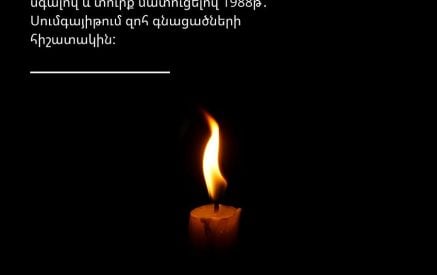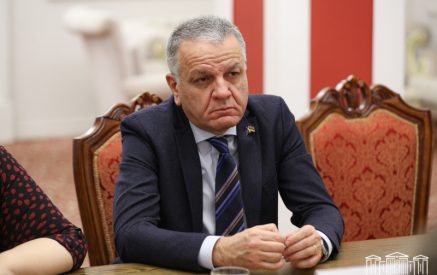C
On February 26-29, 1988, with the actual support of the Azerbaijani authorities and the connivance of the Soviet leadership, a massacre of Armenians was carried out in the city of Sumgait, the Azerbaijani Soviet Socialist Republic, which shocked the international community with its savagery and brutality.
TheSumgaitmassacre of Armenians was committed in response to the Karabakh people’s legitimate expression of will for reunification withArmeniaand became the embodiment of the Azerbaijani authorities’ policy of hatred towards Armenians conducted during the entire Soviet period. The mass pogroms of Armenians in ‘international’Sumgaitwere intended to block a possible solution to the issue, to frighten the Armenians of Nagorno-Karabakh with the prospects of new bloody actions and to make them abandon their national-liberation movement. Dozens of people were killed with sadistic cruelty; a considerable part of them was burned alive after having been beaten, tortured, and violated. Hundreds of people were disabled for life and thousands became refugees…
“After Stalin’s atrocities nothing took place in our country to throw us so far back – from civilization to savagery”, wrote those days scientists from Moscowin their “Open letter to the friends in Armenia”.
Read also
The massacre of Armenians inSumgaitwas thoroughly organized, including from the ideological and psychological points of view. At the anti-Armenian gathering-like rallies, which started on February26 inthe central square, the municipal leaders openly called upon the participants for violence against the Armenians.
On February 27, the ‘rallies’ escalated into acts of violence. The first ‘rally’ in front of the building of the Sumgait City Party Committee was attended by about 50 people; the next day, the number of participants grew to several thousands. In her speech, Second Secretary of the City Party Committee Melek Bairamova demanded that Armenians left Azerbaijan; Azerbaijani poet Khydyr Alovlu concluded his speech by saying: “Death to Armenians!”
In addition to the city leadership, representatives of the law enforcement agencies were on the tribune, and it wasn’t accidental that unprecedented facts of inaction and heartlessness of the Interior employees were fixed during the pogroms.
Following is a fragment from the indictment on criminal case 18/60233 on accusation of Akhmed Imani ogly Akhmedov, Ilham Azat ogly Ismailov, and Yavar Giyas ogly Jafarov: “Answering the question of lawyer Shaposhnikova “Why did you not call your father, who was in service then, to tell him about what was happening in your block?”, witness D. Zarbaliev (the witness’ father worked in the militia in Sumgait) said: “And why did I need to call? The militia knew about it; everybody knew about it. It was not the first day of the pogroms”.
An open atmosphere of mass psychosis and hysteria was formed at the ‘rallies’. Those on the tribunes called upon the rally participants to be true to the credit of the Muslims and to unite in a war against the ‘infidels’. The thugs were inflamed by, actually, fascist appeals, heated by alcohol, which was distributed freely out of trucks, and drugged; convinced of their own impunity, they continued with renewed impetus the pogroms of Armenians’ apartments, their mass beating and killing, which lasted until late at night. The crowd was headed by none other than First Secretary of the Sumgait City Committee of the Communist Party Jahangir Muslimzade, with the national flag ofAzerbaijan in his hands. The gangs were headed also by some prominent people inSumgait – the director of secondary school #25, an actress of the Arablinsky Theater, and others.
“In peacetime, the Soviet Union had never experienced what happened then. Gangs of about ten to fifty or more people strolled through the city, broke windows, burned cars, but the main thing was that they were looking for Armenians”, wrote Rodina (Motherland) magazine (# 4, 1994, pp. 82-90).
On February 28, the number of thugs armed with iron bars, axes, hammers, and other improvised means considerably increased. The crowd clearly knew its tasks. The pogrom-makers, who were divided into groups, broke into Armenians’ apartments and killed the people in their own homes; but more often they took them out in the street or in the yard for making a public mock of them. After painful humiliation, the victims were poured with petrol and burned alive.
Following is a fragment from Hasan Mamedov’s testimony (record of a judicial hearing,Moscow,USSR, the Supreme Court, October 18 – November 18, 1988):
“I saw that a middle-aged man was brought out of the entrance and beaten, mostly from behind… He was lying about three meters from me. A fire was burning nearby. Nizami Mageramov took the guy’s legs and Fizuli Fataliyev took his hands; they lifted the guy off the ground and threw him into the fire. His body turned out to be in the fire and his legs were out of it. I saw it clearly, as it was light. The guy thrown into the fire still showed signs of life. I determined this, seeing how he was trying to roll out of the fire. But, a guy in a black jacket and jeans was holding the guy down in the fire with a piece of reinforcement rod, preventing him from rolling out of the fire…”
Only on February 29 military forces were brought into the city ofSumgait, but they did not immediately establish control over the city. The killings and pogroms of Armenians were going on. Only in the evening the military units started taking decisive actions.
The central authorities were not interested in establishing the exact number of victims in the Sumgaitbacchanalia. Officially, 36 Armenian and 6 Azerbaijani deceased persons were stated. Meanwhile, British researcher Tom de Waal wrote in his book Black Garden. Between Peace and War: “…If you pay attention to the serial numbers of medical death certificates, you’ll find out that at least 115 bodies were recorded those days in the morgues… Such a number of natural deaths is excluded, at least because no more than 72 deaths were registered in the previous two months” («February 1988: Azerbaijan», chapter 2).
The fact that the Genocide of the Armenian population of Sumgait was planned in advance and was not a spontaneous action of a group of hooligans, as the Soviet authorities and judicial agencies tried to present it, is testified by some irrefutable facts: production of cold arms for the pogroms at the industrial enterprises of the city; making lists of the Armenians living in the city with the aim of their killing; the authorities’ inaction; speeches of specially trained provokers at the rallies for manipulating the crowd; the local militia’s assistance to the thugs; disconnecting the phones in the Armenians’ apartments; cutting off the electricity supply in the blocks where the pogroms were going on; accurate coordination of the gangs’ actions; providing the thugs with reinforcement rods, pipe scraps, rocks and bottles with gasoline and alcohol; blocking the entrances to the city by armed groups; lack of any assistance to the victims by medical workers of the city; removal of the crimes’ traces (hasty repair of the smashed shops, apartments, and other facilities), and hiding the organizers and many executors of the Genocide from the justice.
Following is a fragment from the indictment on criminal case 18/60233 on accusation of Akhmed Imani ogly Akhmedov, Ilham Azat ogly Ismailov, Yavar Giyas ogly Jafarov: Witness M. Ilyasov, Russian: “From the window of my apartment I saw a GAS-24 black car to drive up to our block. This car was approached by two men out of the crowd… Without leaving the car, the men sitting in it said something to those who had come up to them, and they immediately went back into the crowd. After that, the pogroms started with renewed fury… I think they fixed in advance the addresses of the Armenians. I came to this conclusion, because the killers entered accurately the entrances where the Armenians lived…
All this was not an act of hooliganism; it was an action against a particular nation, against the Armenians. It was not against the Russians or some other nations, it was against the Armenians; they were looking for only Armenians”.
“Witness S. Guliyev said at the hearing: “Those people were gathered together more than one day, as it is impossible to gather thousands of people in one day.”
“Witness M. Mamedov: “The megaphone-holder (Ahmed Ahmedov) announced that the crowd did not need to smash the apartments, as they would remain to them, they only needed to kill the Armenians”.
“Witness T. Tahmazov, apartment block manager: “Representative of the Azerbaijani Communist Party Central Committee Ganifaeva instructed the rally participants to burn all the smashed things and cover them with ground. They did so, and very quickly. The next morning, the City Executive Committee sent repair and construction teams to block 412 ‘a’ for removing the bodies and the smashed things”.
Sumgait Communist newspaper (#57, May 13, 1988) wrote: “In the days of the heavy situation, axes, knives, and other items that could be used by hooligan elements were made in the shop of the factory (tube-rolling)”.
It is quite obvious that some persons, who were not identified as a result of the investigation, had created favorable conditions for carrying out the mass massacre of Armenians.
On February 29,1988, asession of the Politburo of the USSR Communist Party Central Committee took place in the Kremlin, at which it was stated for the first time officially, though classified as ‘top secret’, that the mass pogroms and massacre had been carried out in Sumgait on an ethnic basis, that is exclusively against Armenians. However, theUSSRofficial structures were quick to taboo the topic of ‘Sumgait’, artificially dividing the mass slaughter of Armenians into separate crimes. The crimes, which, according to the International Convention on Genocide, must be assessed as crimes against the humanity, were classified as crimes committed out of ‘hooliganism motives’. In other words, the committed Genocide was veiled, and its organizers were defended at the official level.
In particular, employees of the municipal and law enforcement agencies remained unpunished, though many witnesses stated some well-known persons in the city, who were directly involved in the ‘rallies’. Moreover, Sumgait Prosecutor Ismet Gaibov, less than a year after the massacre of Armenians in the city, where he ‘carried out’ the control over law and order, was… appointed Prosecutor General of Azerbaijan. Only the Communist leader of Sumgait Muslimzade was dismissed from his position, though he wasn’t either brought to justice. It is rather because at the next plenary session of the Azerbaijani Communist Party Central Committee well-informed Muslimzade directly accused the Republic’s leadership of organizing the massacre: “On May 21, 1988, at the plenary session of the Azerbaijani SSR Communist Party Central Committee, the former First Secretary of the Sumgait City Committee of the Communist Party blamed also the Republic’s leaders for the tragic events in Sumgait. The day before, he stated considerable details of this at the Bureau of the Azerbaijani Communist Party Central Committee, when his personal responsibility was discussed, what can be found in the verbatim records” (the Epoch , # 4, September 13, 1990).
Unfortunately, the February 27-29 pogroms in Sumgait, organized at the highest state level, are not given yet an adequate political and legal assessment, and the Moscow trial did not become the Nuremberg trial, because the roots of the mass crimes were not identified.
The policy of silence related to the Genocide in Sumgait, concealment of the reasons, which gave rise to it, and leaving its real organizers unpunished made possible the ethnic cleansing carried out by the Azerbaijani SSR authorities throughout the Republic, which culminated in the January 1990 bloody bacchanalia in the Republic’s capital city of Baku and led to further large-scale military aggression against the people of the Nagorno-Karabakh Republic.
Meanwhile, the truth about Sumgait, like the materials of the Nuremberg trial, is needed to the people for preventing a new ‘brown plague’.






















































